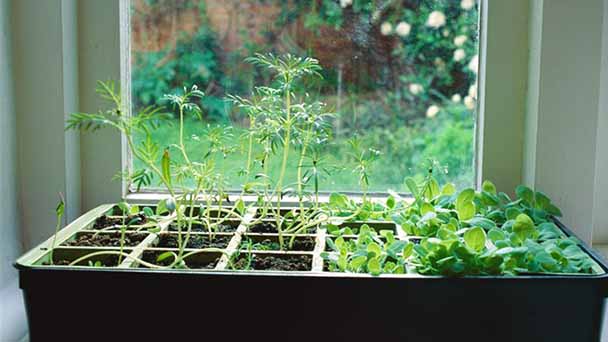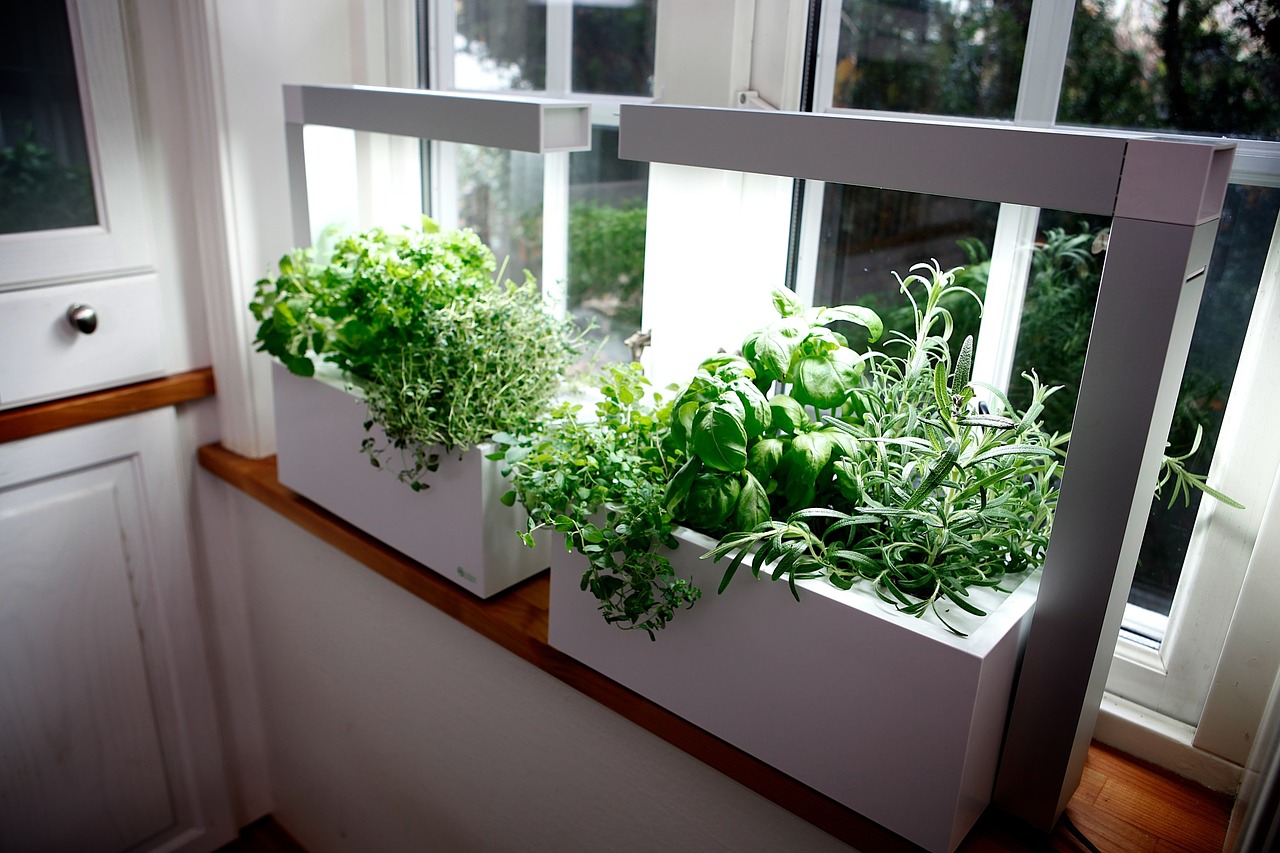Tips for indoor vegetable garden
Written by Joy
Oct 22 2021

The biggest challenge of growing indoor vegetable garden is insufficient light, lack of pollinating insects and wind. However, on the positive side, you can control water, soil and fertility. Unfortunately, pests and diseases may follow you indoors, but since the plant is right under your nose, you should be able to stop the problem before it becomes a major problem. Here are several tips for indoor vegetable garden.
The container should have good drainage and be based on the specific plant size. For example, light root greens only need about 2 inches of depth, but deep rooted tomatoes will require at least 12 inches of soil.
Sunny windows usually don't provide enough light for healthy, short plants. The days are too short, and the light is too low in winter due to plant needs. It’s recommended that some types of supplemental lighting could be provided; whether it is plant light or full-spectrum fluorescent light.
You should not place your plants too close to windows, otherwise they will be exposed to wind or close to heat sources that may dry them.
You'd better let them grow to 8 to 10 inches before harvesting. You ought to cut off what you need, then leave to rest. You usually only get one flush from each clove. They may sprout again, but the quality decreases, so start new cloves when you start harvesting the current crop.
You ought to let the plants grow at least 4-6 inches tall before starting to harvest. It's a good idea to cut or pull the outer leaves to let the center of the plant continue, which is good for your indoor vegetable garden.
Since these green vegetables will be harvested as seedlings, you do not need much soil. The shallow (2 inches deep) tray works well. You should fill with soil, moisten and sow your seeds. There is almost no need to cover the seeds with soil, but lightly press to keep the seeds in good contact with the moist soil and not dry out. You’d better use a gentle stream of water or spray water to keep the soil moist, you should see sprouts within a few days.
When the seedlings started to be harvested, they had developed about 2 sets of true leaves. Cut them off at the soil level with scissors and you may get another growth.
Some gardeners have succeeded in replenishing only the roots of the green onions they bought after using the tops. You could put the whole green onion in a glass of water and put them in a glass with only about 1 inch of water at the bottom. When the roots reached a few inches in length, moving them to a shallow container and let them continue to grow. You can harvest only the green tops, leaving about 1 inch of stems for re-growth, or remove all shallots from the container to use the white parts.
When you move the seedlings to a new pot, you should start feeding them with water-soluble organic fertilizers. Once the plants begin to place the flowers, they need to be shaken regularly to allow the pollen to fall from the flowers. Without pollination, no fruit will be formed. Plants may become the heaviest and may need to be staked.
General indoor planting indoor vegetable garden techniquesGrowing carrots indoorsGarlic plantGrow decorative peppersLettuce and other salad vegetablesDaikon leavesHow to grow spring onionsGrowing tomatoes indoors
General indoor planting indoor vegetable garden techniques
You'd better use high-quality potting mix instead of garden soil.The container should have good drainage and be based on the specific plant size. For example, light root greens only need about 2 inches of depth, but deep rooted tomatoes will require at least 12 inches of soil.
Sunny windows usually don't provide enough light for healthy, short plants. The days are too short, and the light is too low in winter due to plant needs. It’s recommended that some types of supplemental lighting could be provided; whether it is plant light or full-spectrum fluorescent light.
You should not place your plants too close to windows, otherwise they will be exposed to wind or close to heat sources that may dry them.
Growing carrots indoors
Carrots are ridiculous adaptations. Growing them in containers is not only a good choice for indoor vegetable gardeng, it also solves the problem of trying to plant them in heavy rocky soil. Baby carrots are one of the easiest indoor vegetable garden to grow. They need less space and mature quickly. Since you will plant multiple plants-unlike a single pepper or tomato plant-a long container, like a window frame. The key to good germination is to keep the soil moist. As long as the seeds are lightly covered with moist peat moss, the seeds will not dry out, but they will not form a hard shell to prevent germination. The seeds should germinate within 2 weeks. The maturity date will depend on the variety you plant.Garlic plant
Garlic has very special temperature requirements and can form bulbs, but you can easily get a stable head of garlic, or can be used to replace green onions. You don't need a garlic sprout container. A depth of about 4 inches is sufficient. You should just plant a single clove about 1 inch deep and water regularly. The cloves should germinate in about 1 week.You'd better let them grow to 8 to 10 inches before harvesting. You ought to cut off what you need, then leave to rest. You usually only get one flush from each clove. They may sprout again, but the quality decreases, so start new cloves when you start harvesting the current crop.

Grow decorative peppers
Smaller pepper yields are worse than larger varieties, although not as good as outdoor vegetable garden. You can use a container that is at least 8 inches tall. Chili needs at least 10 hours of light a day. You shouldn't be on the water. You should allow the container to dry out between watering. These plants are self-pollinating, but you may need to help them. You can push the plant to shake pollen from one flower to another, or you can use a cotton swab to bring pollen to each flower in your small indoor vegetable garden.Lettuce and other salad vegetables
Lettuce grows fast and has a shallow root system, so there is no need for deep containers. If you go to the route again, it will continue to grow. You'd better choose a container with a depth of 2-4 inches and fill it with moist soil. You should sow your seeds and gently press them into the soil surface. The mist keeps the seeds moist, and you should see germination within 1 week.You ought to let the plants grow at least 4-6 inches tall before starting to harvest. It's a good idea to cut or pull the outer leaves to let the center of the plant continue, which is good for your indoor vegetable garden.
Daikon leaves
These fresh shoots are probably the easiest to eat indoors. They do not take up too much space or too much time. Microgreens are just mixed seeds of various vegetables and herbs, such as beets, radishes, kale, beets and basil.Since these green vegetables will be harvested as seedlings, you do not need much soil. The shallow (2 inches deep) tray works well. You should fill with soil, moisten and sow your seeds. There is almost no need to cover the seeds with soil, but lightly press to keep the seeds in good contact with the moist soil and not dry out. You’d better use a gentle stream of water or spray water to keep the soil moist, you should see sprouts within a few days.
When the seedlings started to be harvested, they had developed about 2 sets of true leaves. Cut them off at the soil level with scissors and you may get another growth.
How to grow spring onions
You can't grow onions indoors, but garlic, such as garlic green, does well. In fact, they may easily contend with the micro-green team. You don't even need seeds.Some gardeners have succeeded in replenishing only the roots of the green onions they bought after using the tops. You could put the whole green onion in a glass of water and put them in a glass with only about 1 inch of water at the bottom. When the roots reached a few inches in length, moving them to a shallow container and let them continue to grow. You can harvest only the green tops, leaving about 1 inch of stems for re-growth, or remove all shallots from the container to use the white parts.
Growing tomatoes indoors
We are used to seeing our tomato plants die at the end of the season, but tomatoes are tropical perennials. It's not recommended to keep your indoor vegetable garden, they may be too big and have already encountered problems at the end of the season. However, new plants from seed can be grown indoors at the end of summer. Tomato seeds germinate fairly quickly. Once the seedlings are 3 to 4 inches tall, you should move them to their permanent pots and make sure they have at least 10 hours of light per day. This is a lot, but this is a sturdy plant that needs so much light in winter.When you move the seedlings to a new pot, you should start feeding them with water-soluble organic fertilizers. Once the plants begin to place the flowers, they need to be shaken regularly to allow the pollen to fall from the flowers. Without pollination, no fruit will be formed. Plants may become the heaviest and may need to be staked.
Check our article on 35 Most Common House Plants with Pictures & Care Guide
Latest Updated
- Benefits of Bugleweed - 7 Science-backed Health Benefits
- Bugleweed Dangers & Side Effects - Is It Poisonous?
- How to Plant Evergreen Trees - What You Should Know
- When to Plant Evergreens - Grow Guide for Evergreen Trees
- 12 Wonderful Evergreen Shrubs for Your Garden
- 12 Popular Evergreen Plants with Pictures for Beginners
- When And How To Prune A Lilac Bush Like a Pro
- How to Grow & Care for Lilac Vine (Hardenbergia Violacea)
- Japanese Lilac Tree (Syringa Reticulata) Care & Propagation Guide
- Shumard Oak Pros and Cons - What to Know
Popular Articles
- Winter maintenance of Antirrhinum Majus
- How to Grow Terminalia Mantaly Tree
- How to Grow and Care for Crossostephium Chinense
- How to grow Antirrhinum Majus in spring
- Peristeria Elata (Dove Orchid) Profile: Info & Care Guide
- Underwatered Snake Plant (Sansevieria Trifasciata) - Signs And How To Fix
- How to Care for Brazilian Jasmine Plant (Mandevilla Sanderi)
- How to Grow & Care for Graptopetalum Purple Delight in Summer
- Rosa Chinensis (China Rose): Plant Growing & Care Tips
- How to Care for Baby Sun Rose (Aptenia Cordifolia)